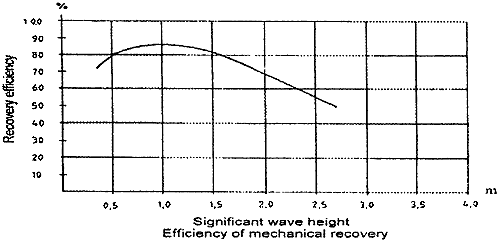
Fig.2
From the skimmer capacities which have been established during realistic trials in different weather conditions, the following must be deducted in order to estimate how much pure oil it is possible to recover:
- Free water collected together with the emulsion.
- Water content of the emulsion (most oils will absorb water and form an emulsion, water content can be as high as 70%)
- Time needed to transfer recovered oil to tankers.
- Allow time for field repairs.
Average recovery rates over a period of time can be as low as 20% of normal rates when the above has been taken into account.
Efficiency of Mechanical Oil Recovery in Marginal or Bad Weather
If breaking waves exceeds 3.5 - 4 m in significant height, mechanical recovery rapidly become impossible. Fig. 2 indicates 0 efficiency at around 4 m. From time to time there is equipment promoted where high foul weather efficiency is claimed. We believe this to be misleading for several reasons. With the presence of breaking waves of any size most of the oil will disappear from the surface and into the water column. If the oil is broken into fairly large droplets it will be distributed in the water down to a depth equal to the wave height. In this case the oil may surface again if the weather calms down. With smaller droplets the oil will be naturally dispersed into the water column. Further, the oil which remains on or in the vicinity of the surface will be impossible to contain in a boom because of the apparent increase in current velocity caused by the waves.
C. Measures Taken to Combat Continual Crude Oil Leakage from Ocean-floor Oil Fields. Combating Incidents on Ocean-floor.
Oil recovery operations aimed at collecting oil from underwater blow outs or leakage from sub sea pipelines are much the same as for oil spilt on or near the surface. The main difference is that the oil most likely will spread over a much larger area and consequently form a much thinner layer on the surface. This complicates the recovery operation in the sense that more equipment, especially booms, is needed (see Fig. 1). The boom loss, which always occurs when drifting oil is contained and subsequently concentrated by the forward motion of the boom, will proportionately increase with the extra amount of boom required.
If the release velocity on the bottom is high enough, recent field trails (in the North Sea in 1996 ) have shown that the oil will form very small droplets with small rise velocity. In the case of the 1996 field trails the oil slick which formed on the surface had a thickness in the order of 5 - 20 mm. In this case, the oil film was too thin to be recovered. The energy conveyed to the water surface by the booms caused the oil to disperse into the water column. This indicates that some underwater oil spills may be impossible to recover even under reasonable weather conditions.